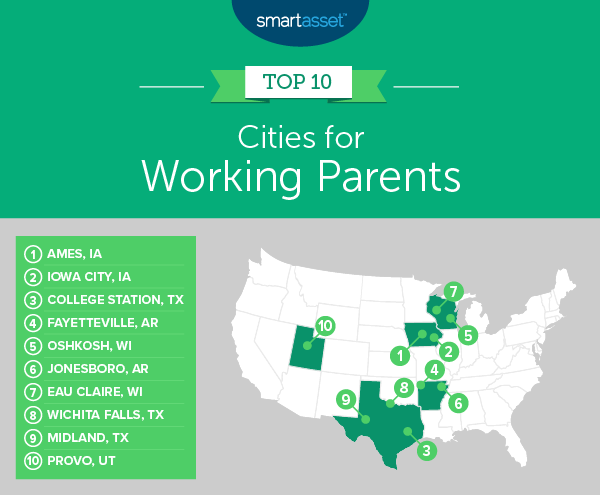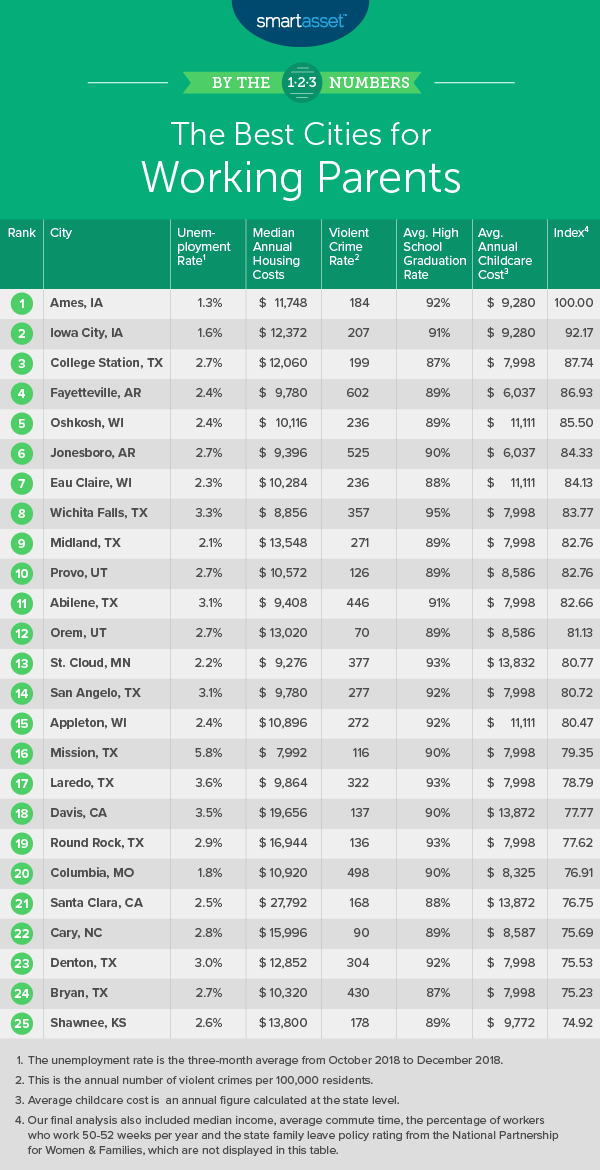In about 62% of two-parent households, both parents work, according to 2017 data from the Bureau of Labor Statistics. That’s up about 1% from the previous year. Not only are more parents working, but Census data also shows that men and women across the country worked more in 2017 than in 2016. It’s also not much of a surprise that more parents are working. Housing costs, childcare and the overall cost of living continue to rise while incomes have seen less growth. So if you want to make ends meet now while also achieving big goals like buying a home and socking away money in a savings account, you’ll need to work more. Considering multiple factors, we created this list of the best cities in the U.S. for working parents.
In order to find the best cities in the country for working parents, we considered data on nine metrics. We looked at data on the unemployment rate, median household incomes, median annual housing costs, the percentage of the workforce working more than 49 weeks per year, average commute times, crime rates, graduation rates, state family leave policies and the costs of childcare.
This is SmartAsset’s fourth annual look at the best cities for working parents. You can see the best cities for working parents in 2018 here.
Key Findings
- The middle of the country scores big. None of the cities in our top 10 are along the coasts. Instead, cities closer to the center of the country do well. California has one city in the top 20, and the first city from the Northeast is Cambridge, Massachusetts, at 60. A big part of why the coasts do poorly is the high cost of living in many coastal states.
- Four states stand out. Nine of the top 10 cities are in Arkansas, Iowa, Texas or Wisconsin. That’s even more than last year, when those four states accounted for six of the top 10 cities. It isn’t just one metric that helps these cities and states do well. They tend to do well across all metrics. The notable exception is that median incomes tend to be low in these places relative to the other cities in the study. That may not necessarily be a problem, though, since housing costs (which often constitute a significant portion of household expenses) also tend to be relatively low.

1. Ames, IA
Ames, Iowa tops our ranking of the best cities for working parents for the second year in a row. One big reason for this top ranking is that over the final three months of 2018, Ames saw the lowest average unemployment rate in our study at just 1.30%. That low unemployment is part of why the city also tops our 2018 list of the best cities for career opportunities.
While Ames ranks about average in terms of median incomes, those incomes are enough to cover housing costs. Annual housing costs make up just 22.65% of the median annual income. Getting to work is also manageable. The average commute time for residents is less than 18 minutes and ranks in the top 10% of the study. And since schools are a major concern for many parents, you may be happy to hear that Ames has the 29th-highest high school graduation rate in the study, at 92.30%.
2. Iowa City, IA
Moving up one spot from last year is Iowa City, Iowa. In most metrics, Iowa City isn’t far behind the No. 1 spot. The unemployment rate is 1.60%. That’s second-lowest out of the 524 cities we considered. Annual housing costs are affordable at less than 25% of the median income, and the low violent crime rate ranks among the best 25% of cities. The city also ranks in the top 10% for its high school graduation rate of 90.70%.
If you’re considering buying your first home in Iowa City, make sure to check out some of the first-time homebuyer programs available in Iowa.
3. College Station, TX
After missing out on last year’s top 10, College Station, Texas once again ranks as a great place for working parents. For one, unemployment in the city is relatively low at 2.70%. Getting to work is also easy, given an average commute time of about 16 minutes. That’s the 20th-shortest commute time in the study. College Station ranks among the safest in the study with a violent crime rate that ranks in the top 25% of all cities. Childcare costs are low and rank in the top 12% of cities.
4. Fayetteville, AR
Cracking the top 10 for the first time is Fayetteville, Arkansas. The biggest reason is that the average annual cost of full-time center-based childcare ranks in the top 10 of the study. About nine out of 10 children also go on to graduate from high school. Additionally, the low housing costs in Fayetteville rank in the top 12% of all cities. Parents looking for work will appreciate that the city’s unemployment rate is just 2.40%. That’s well below both the national rate and the overall unemployment rate in Arkansas, according to the Bureau of Labor Statistics. Workers should also note that the Fayetteville metro area is one of the best places for creatives.
5. Oshkosh, WI
After ranking seventh, then eighth and then ninth over the past three years, Oshkosh, Wisconsin claims a top-five spot for 2019. As you consider different cities in which to raise your family, be sure to take into account that Oshkosh ranks in the top 30% for both its low crime rate and its high school graduation rate of nearly 90%. The unemployment rate of 2.40% ranks in the top 7% (37th-best overall) and an average commute time of just 17.4 minutes means it’s relatively easy to get to work. The median income in Oshkosh is less than $50,000. But housing costs, which include property taxes and homeowners insurance, are also affordable. Annual housing costs only make up about 20% of the median annual income. That’s a very low rate.
6. Jonesboro, AR
Jonesboro, Arkansas is similar to Fayetteville in that it can partially thank low childcare costs for its spot in this study’s top 10. The city has a top-10 score in that metric. Local schools can take pride in Jonesboro’s 90% high school graduation rate. That rate ranks in the top 16% of all 524 cities in this study. Housing in the city is also affordable. In fact, Jonesboro ranks in the top 10% of all cities for this metric.
7. Eau Claire, WI
Rising nine spots from last year is Eau Claire, Wisconsin. The city ranks well in both job- and family-related metrics. The unemployment rate of 2.30% ranks in the top 6% of cities in our study. The annual housing costs are relatively low and rank in the top 20% of our study. And even though median incomes aren’t necessarily among the highest in the study, housing costs make up less than 20% of the median income. That’s a very low rate relative to the Census Bureau’s recommended maximum of 30%. Getting to work takes just 16 minutes on average, the 19th-best rate overall in the study. Eau Claire also ranks in the top 30% for its low violent crime rate.
8. Wichita Falls, TX
A few metrics stand out when looking at Wichita Falls, Texas. For one, the average commute time to work is just 14.40 minutes. That’s the lowest in the entire study. In addition to the likely savings on gas that the short commute time brings, annual housing costs in the city are low, at about $8,800. The other standout metric for Wichita Falls is its high school graduation rate. At 94.70%, the city has the second-highest rate of the 524 cities in this study. Coupled with the low childcare costs, which average less than $8,000 per year, parents have a lot to appreciate if considering raising a family here.
9. Midland, TX
The metric that most helps Midland, Texas rank in the top 10 this year is its unemployment rate. At 2.1%, Midland has the 15th-lowest unemployment rate in the study. The median income in the city is also quite high at approximately $75,000. That ranks in the top 25% of all cities in this study. The average commute time of 20 minutes also ranks among the best 25%. Childcare costs are low in Texas overall and the Midland high school graduation rate comes in at 89.20%, which puts it in the top 25% of the study for this metric.
10. Provo, UT
Rounding out this top 10 is Provo, Utah. While it fell eight spots from last year, it’s still a great city for working parents. Unemployment is low at 2.70%. The median annual income, while lower than other cities in the study, still help residents to afford housing. Annual housing costs make up 24.51% of the median income. Getting to work is also relatively quick, with an average commute time of 18.30 minutes for residents. That leaves time for parents to enjoy with their families. Crime rates in Provo are also among the lowest we found, in the top 11% of the study.

Data and Methodology
SmartAsset created this list of the best cities for working parents by looking at data for 524 cities. Specifically, we compared the cities across the following nine metrics:
- Unemployment rate. This is the average unemployment rate for the three months of October, November and December of 2018. Data comes from the Bureau of Labor Statistics and is measured at the county level.
- Median household income. This is the annual income for the median household. Data comes from the Census Bureau’s 2017 1-year American Community Survey.
- Median annual housing costs. This looks at the annual housing costs for the median home. Data comes from the Census Bureau’s 1-year 2017 American Community Survey.
- Percentage of workforce working more than 49 weeks per year. This is the percentage of workers who work 50 or more weeks per year. Data comes from the Census Bureau’s 2017 1-year American Community Survey.
- Average commute time. This is the average number of minutes is takes to get to work. Data comes from the Census Bureau’s 2017 1-year American Community Survey.
- Violent crime rate per 100,000 residents. This is the number of violent crimes per 100,000 residents. Data comes from the FBI Uniform Crime Reporting Program and is for 2017. We used 2016 data where 2017 data was unavailable.
- Graduation rate. This is the average high school graduation rate. Data comes from the U.S. Department of Education and is for the 2016-2017 school year. Where the most recent data was unavailable, we used data from the 2015-2016 school year.
- State policy rating. This metric is a score created by the National Partnership for Women & Families. It rates states based on the level of support that they offer working parents. A higher score indicates a state has laws and policies (like paid family leave) that are friendlier to working parents.
- Annual childcare costs. This is the average annual cost of full-time center-based childcare. We took the average cost of care for children between infancy and 4 years old. Data comes from Childcare Aware of America.
To create our list of the top cities, we first ranked each city in each metric. Then we found each city’s average ranking, giving all metrics equal weight. We used this average ranking to create our final score. The city with the best average ranking received a score of 100, while the city with the worst average ranking received a score of 0.
Tips for Managing Your Savings
- Save for an emergency. One of the best ways to protect yourself financially is to have an emergency fund. An emergency fund is money you put aside so that you have it in case of an unplanned expense. For example, a fund can protect you if you need to make an unexpected car repair or if a family member is sick and you need to pay for medicine.
- Make your money work for you. While building savings, it’s important to get the best interest rate possible. If you put your money into a savings account with 0.10% interest, the national average, you’d be earning almost nothing in interest. Opt instead for a high-yield savings account. With interest rates of 2% or more, these accounts earn you far more money, with less work on your part.
- Talk to an expert. Managing your finances is challenging. This is especially true if you have student loans, kids, a mortgage, car payments and maybe even bills for your pets. Create a plan to help you stay on top of everything. Outline how much you have, how much you can spend and how you’re going to spend that money. Make sure you prioritize saving both for now and for your retirement. To help you do this, consider speaking with a financial advisor. An advisor is an expert who can sit down with you to create a comprehensive plan based on your personal situation. This free financial advisor matching tool will help you quickly find advisors who are in your area and meet your requirements.
Questions about our study? Contact us at press@smartasset.com
Photo credit: ©iStock.com/pixdeluxe
